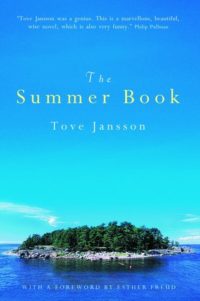You see nothing but what you’re looking for
 The Summer Book
The Summer Book
by Tove Jansson
translated from Swedish by Thomas Teal
This Scandinavian modern classic isn’t well known over here. I forget which book blogger alerted me to its existence but whoever you are, thank you! It is a thoroughly lovely book.
It’s the story of young Sophia (her age is never given exactly) and her grandmother over the course of a few summers spent at their family home on a tiny island in the gulf of Finland. The events are mostly small, such as Sophia’s first camping experience or going “gathering”. (Note: I’m not sure if the quotes I’ve chosen convey this, but I did find the writing style took some getting used to. It feels a little simplistic, as if a child is being addressed. But once used to it I enjoyed this style.)
“Gathering is peculiar, because you see nothing but what you’re looking for. If you’re picking raspberries, you see only what’s red, and if you’re looking for bones you see only the white. No matter where you go, the only thing you see is bones…Sophia and Grandmother carried everything they found to the magic forest. They would usually go at sundown. They decorated the ground under the trees with bone arabesques like ideographs, and when they finished their patterns they would sit for a while and talk.”
Sophia’s father is also there but for much of the book he is near-invisible. The crux is very much the relationship between grandmother and granddaughter, which is not one I have ever seen explored much at all, and certainly never this well. Grandmother is as open about her impending death as the family is silent about the recent death of Sophia’s mother, which is only briefly mentioned in the opening chapter. Grandmother muses on her old age philosophically, sharing wisdom with Sophia. They tell each other stories about the things they see, fantasies rooted in reality.
“Out on a flat rock in the water lay a scolder. It was wet and dead and looked like a wrung-out plastic bag…
‘How did it die?’ Sophia yelled. She was very angry.
‘Of unrequited love,’ her grandmother explained. ‘He sang and scolded all night for his scolder hen and then along came another and stole her away, so he put his head under the water and floated away.’
‘That’s not true,’ Sophia screamed. She started to cry. ‘Long-tails can’t drown. Tell it right!’
So grandmother told her he had simply hit his head on a rock…
‘That’s better,’ Sophia said.”
The setting is also pretty unusual. The island is small – barely much bigger than the house. The family grow vegetables and go fishing but mostly they take their boat to the village for supplies. Each of their neighbours lives on a different island but theirs is the furthest out, the most isolated – until the chapter when some stranger starts building on the next island even further out.
It is an intense isolation, especially for Sophia, who is reliant on the adults to take her anywhere. The result is that she – and we along with her – knows the island minutely, both its nature and its man-made features. This detailing of nature is something I can find, in other books, a bit dull, but here it was never that. Perhaps it was Sophia’s straightforward childish attitude. Or perhaps it’s my inclination for the sea, and my wish to be there with them getting to know the sea’s moods. Or maybe it’s that this book always retains its sense of humour, a wryly original outlook.
“Sophia went through a rebellious phase one cold, rainy summer when being unhappy outdoors was a lot of trouble. So she would go up in the attic to be alone…In between times, she played cards with her grandmother. They both cheated shamelessly, and their card-playing afternoons always ended in a quarrel…Grandmother tried to recall her own rebellious periods in order to try and understand, but all she could remember was an unusually well-behaved little girl. Wise as she was, she realised that people can postpone their rebellious phases until they’re eighty-five years old, and she decided to keep an eye on herself.”
Another intensity is the summer itself, with its burning heat, endless light and empty days. There is a languid contemplation to much of the book, a reflective quality that makes sense when you learn that this is semi-autobiographical. Sophia is Jansson’s niece of the same name, Papa is her brother Lars (the cartoonist who drew the Moomins comic strip) and Grandmother is her mother Signe – or at least the characters are based on those people, but fictionalised to some degree. Less fictionalised is the setting. The exact place is never named but the introduction to my copy of the book, written by Esther Freud, talks about visiting Sophia Jansson on that same island and in that same house, 30 years after this book was written, finding it exactly as described.
I can see why this book was an instant success and easily imagine myself returning to it over the years. It is sad and thoughtful and gently funny. The relationship between Sophia and Grandmother is truly lovely – both get cross at their limitations and take it out on each other, but they also take care of each other in very sweet ways and very sensible everyday ways. I’m also intrigued to read some of Jansson’s other novels.
Sommerboken published 1972.
This translation first published 1974 by Random House.
This edition published 2003 by Sort Of Books.
Source: Amazon.
Challenges: This counts towards the Classics Club.